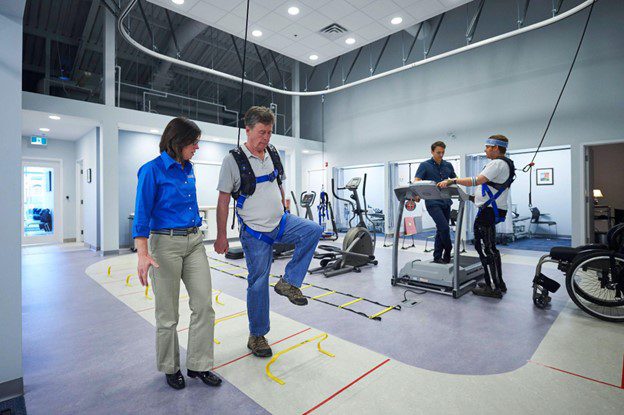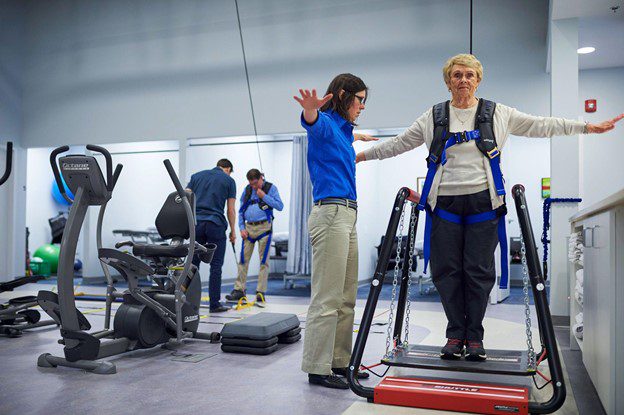Solo-Step: The Best Assistive Device for Spinal Cord Injury in 2024

Living with a spinal cord injury (SCI) can be incredibly challenging. According to the World Health Organization, more than 15 million people worldwide live with spinal cord injuries. Spinal cord injuries affect mobility, independence, and quality of life. However, technological advancements continue to bring hope and innovation to the field of rehabilitation and assistive devices. Among many assistive devices that help individuals with spinal cord injuries, the Solo-Step Overhead Track and Harness System has given confidence, strength, balance, and coordination to millions of patients with spinal cord injuries. In this blog, we’ll explore why Solo-Step is hailed as one of the best assistive devices for spinal cord injuries.
What is Solo-Step?

Solo-Step is a simple and effective overhead track and harness system designed to provide support and safety for individuals participating in physical therapy or rehabilitation. Solo-Step is designed to help those with SCI, balance issues, individuals who fear falling, and more. The Solo-Step Overhead Track System consists of a ceiling-mounted track, a secure harness, and a lanyard and trolley that moves smoothly along the track, allowing users to practice walking, balancing, and more without the fear of falling.
Key Features and Benefits
1. Enhanced Safety
Safety is paramount for individuals with SCI. Solo-Step aluminum track securely supports up to 2000 pounds per 7-and-a-half-foot track section, preventing falls and reducing the risk of injury during rehabilitation exercises. This added safety net encourages users to push their boundaries and engage in more intensive rehabilitation sessions. When the user knows they won’t fall, they are more confident and comfortable to attempt challenging exercises. This leads to faster progress for each patient while staying safe from injuries.
2. Promotes Independence

Solo-Step empowers users by promoting independence. Unlike traditional rehab methods that may require constant assistance from therapists or caregivers, Solo-Step allows individuals to practice walking and other movements independently. This helps patient recovery while enhancing psychological well-being by fostering a sense of accomplishment and self-reliance. Therapists can stand back and view the patient’s full body alignment during therapy, allowing them to assist their patients while making any necessary adjustments.
3. Solo-Step Is Customizable and Adjustable
Every individual’s needs are unique, especially when it comes to SCI rehabilitation. Solo-Step is highly customizable, with adjustable harnesses and track lengths/sizes to accommodate various heights and body types.
The Solo-Step Ceiling Track can be completely customized to your facility. Our curved and straight track sections allow you to place track sections over various equipment, including treadmills, parallel bars, and more.
The Solo-Step Overhead Track System can be installed in most ceiling types. The following upper structures are ideal for the installation of the Solo-Step Overhead Track System:
- Concrete slab
- Metal pan deck
- Wood truss
- Metal joists
- Cement
- And more
The usability and flexibility of the Solo-Step ensure that users receive personalized support tailored to their specific needs, making the rehabilitation process more effective and comfortable.
4. Facilitates Comprehensive Rehabilitation
Rehabilitation for SCI involves a multifaceted approach, including physical therapy, strength training, and gait retraining. Solo-Step seamlessly integrates into your existing rehabilitation programs, allowing therapists to implement a wide range of exercises. Solo-Step supports:
- Gait training
- Balance exercises
- Strength training
- Dual-task exercises
- And more
5. Boosts Confidence and Motivation
One of the most significant barriers to SCI rehabilitation is the fear of falling and the anxiety it causes. According to Science Direct Topics, 42% to 72% of older adults who have fallen develop a fear of falling.
Solo-Step alleviates the fear of falling by providing a secure environment for practice. As users become more confident in their abilities, their motivation to participate in rehabilitation sessions increases, leading to better outcomes and faster progress.
Users of Solo-Step can expect:
- Decreased fear of falling
- Increased confidence
- Ability to challenge themselves
- A safe environment during balance, strength, and gait training
- 100% safety from fall-related injuries
6. Reduces Therapist Injuries & Back Strain
Physical therapists and physical therapist assistants are susceptible to occupational musculoskeletal injuries. According to a study of 500 PTs and PTAs by the National Library of Medicine, 32% of the PTs and 35% of the PTAs reported sustaining a musculoskeletal injury. Many PTs and PTAs experience lower or upper back strain as a result of handling and lifting their patients.
Solo-Step provides patient support so therapists do not have to suffer musculoskeletal injuries during treatment. While your patient is in the Solo-Step Overhead Track System, they will be protected from falling and hitting the ground. Utilizing Solo-Step with your patients results in fewer patient and therapist injuries.
7. Versatile Applications
While Solo-Step is highly effective for SCI rehabilitation, it can also be used for individuals with various mobility impairments. Solo-Step is extremely effective for those recovering from strokes, traumatic brain injuries, or other neurological conditions. The versatility of Solo-Step makes it a valuable investment for your facility!
Real-Life Success Stories
Over 1000 facilities throughout the United States and Canada use the Solo-Step with their patients to prevent dangerous falls and injuries. Numerous facilities have shared their patient successes while using the Solo-Step Overhead Track & Harness System.
Project Walk Boston is a globally recognized organization that focuses on enhancing the quality of life for individuals impacted by Spinal Cord Injuries, Paralysis, and other mobility-related disorders. Project Walk Boston uses their Solo-Step Overhead Track System in creative ways to help their patients recover safely and effectively.
Lindsay’s Progress
Project Walk Boston’s patient, Lindsay, has been working extremely hard with her therapists at Project Walk Boston. By utilizing the Solo-Step to improve her gait, balance, and coordination, she has gained confidence and strength! Check out the full video below!
The Recovery Project uses advanced, focused, and evidence-based rehabilitation to help those affected by mobility impairments. The Recovery Project aims to help patients live fuller and more independent lives. By using equipment like the Solo-Step, they can improve their patients’ gait, balance, and strength while keeping them safe during all aspects of rehabilitation.
Kiasia’s Progress
The Recovery Project used the Solo-Step with their patient, Kiasia, to improve her gait pattern and gait speed. With Solo-Step, The Recovery Project was able to challenge Kiasia with high-intensity gait training (HIGT). High-intensity gait training involves walking or stepping at a fast enough pace to keep the heart rate at 60-80% of its maximum heart rate. This helps patients regain strength and endurance faster than without utilizing HIGT. Check out Kiasia’s progress in the video below!
Contact Us to Learn More About the Solo-Step Overhead Track & Harness System!
Solo-Step has emerged as an essential assistive device for spinal cord injury and other neurological conditions. Its versatility, safety, and ability to give patients independence make it an invaluable tool for individuals on their journey to recovery. By enhancing confidence, promoting comprehensive rehabilitation, and facilitating independence, Solo-Step offers hope for those living with SCI and other neurological conditions. To learn more about the Solo-Step Overhead Track System, click the button below!